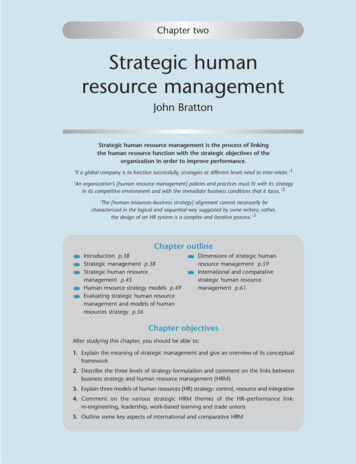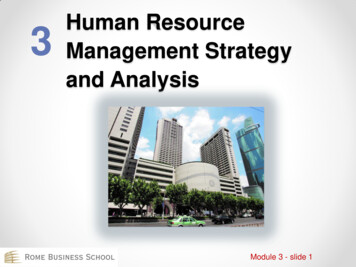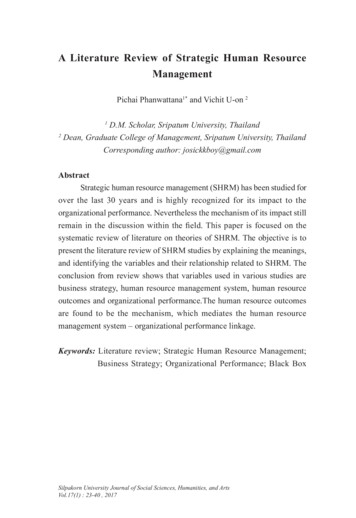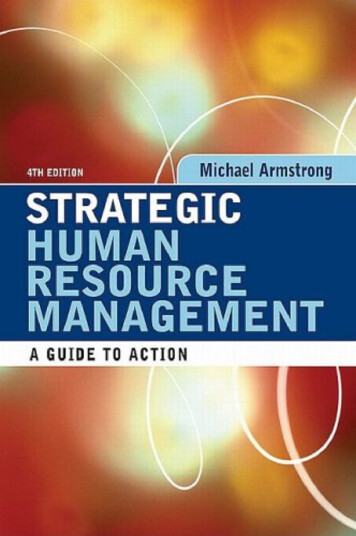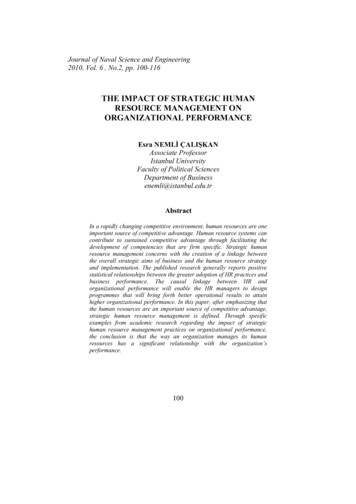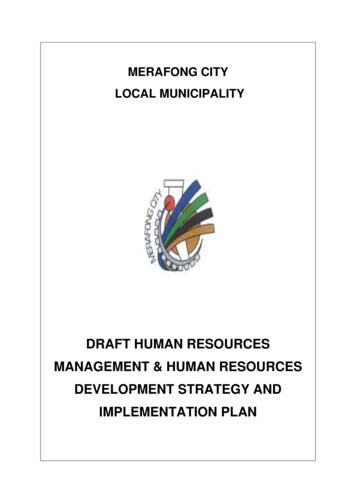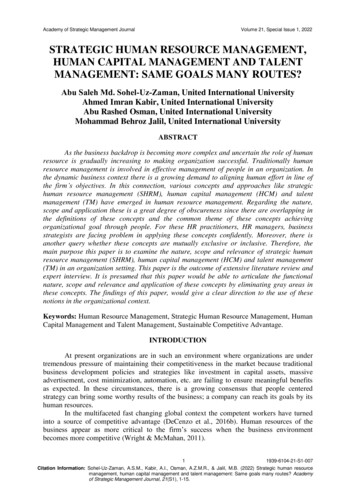
Transcription
Academy of Strategic Management JournalVolume 21, Special Issue 1, 2022STRATEGIC HUMAN RESOURCE MANAGEMENT,HUMAN CAPITAL MANAGEMENT AND TALENTMANAGEMENT: SAME GOALS MANY ROUTES?Abu Saleh Md. Sohel-Uz-Zaman, United International UniversityAhmed Imran Kabir, United International UniversityAbu Rashed Osman, United International UniversityMohammad Behroz Jalil, United International UniversityABSTRACTAs the business backdrop is becoming more complex and uncertain the role of humanresource is gradually increasing to making organization successful. Traditionally humanresource management is involved in effective management of people in an organization. Inthe dynamic business context there is a growing demand to aligning human effort in line ofthe firm’s objectives. In this connection, various concepts and approaches like strategichuman resource management (SHRM), human capital management (HCM) and talentmanagement (TM) have emerged in human resource management. Regarding the nature,scope and application these is a great degree of obscureness since there are overlapping inthe definitions of these concepts and the common theme of these concepts achievingorganizational goal through people. For these HR practitioners, HR managers, businessstrategists are facing problem in applying these concepts confidently. Moreover, there isanother query whether these concepts are mutually exclusive or inclusive. Therefore, themain purpose this paper is to examine the nature, scope and relevance of strategic humanresource management (SHRM), human capital management (HCM) and talent management(TM) in an organization setting. This paper is the outcome of extensive literature review andexpert interview. It is presumed that this paper would be able to articulate the functionalnature, scope and relevance and application of these concepts by eliminating gray areas inthese concepts. The findings of this paper, would give a clear direction to the use of thesenotions in the organizational context.Keywords: Human Resource Management, Strategic Human Resource Management, HumanCapital Management and Talent Management, Sustainable Competitive Advantage.INTRODUCTIONAt present organizations are in such an environment where organizations are undertremendous pressure of maintaining their competitiveness in the market because traditionalbusiness development policies and strategies like investment in capital assets, massiveadvertisement, cost minimization, automation, etc. are failing to ensure meaningful benefitsas expected. In these circumstances, there is a growing consensus that people centeredstrategy can bring some worthy results of the business; a company can reach its goals by itshuman resources.In the multifaceted fast changing global context the competent workers have turnedinto a source of competitive advantage (DeCenzo et al., 2016b). Human resources of thebusiness appear as more critical to the firm’s success when the business environmentbecomes more competitive (Wright & McMahan, 2011).11939-6104-21-S1-007Citation Information: Sohel-Uz-Zaman, A.S.M., Kabir, A.I., Osman, A.Z.M.R., & Jalil, M.B. (2022) Strategic human resourcemanagement, human capital management and talent management: Same goals many routes? Academyof Strategic Management Journal, 21(S1), 1-15.
Academy of Strategic Management JournalVolume 21, Special Issue 1, 2022This realization is not new; long before, Porter and Advantage (1985) stressed the roleof human resources as the originator of competitive advantages at any business. As anobvious reason, efficient utilization of human resource is at the center of contemporarybusiness strategy. There is a considerable amount of discussions, how human resource canserve the business most. In order to ensure effective utilization of human resource, there arethree dominating concepts in human resource management. These are: strategic humanresource management, human capital management and talent management. The commontheme of these concepts is: human are the unique resources that can enhance businessperformance and lead to competitive advantage. Due to this common theme often theseconcepts appear as analogous. There is a great degree of ambiguity regarding the precisenature of these concepts and their applications. There is confusion whether these concepts aremutually exclusive or inclusive. Firms, HR practitioners, HR managers, business strategistsare looking for a clear description of these concepts along with their purposes, scopes, andapplications so that they can use these concepts for their business success more confidently.Objective, Scope and Significance of the StudyThe core objective of this study is to explain the terms - strategic human resourcemanagement (SHRM), human capital management (HCM) and talent management (TM),along with their scope, relevance and application. While attaining these purposes, this paperwould clarify: how these concepts are different from each other; what is the rational of usingthese concepts; and whether these concepts are mutually inclusive or exclusive in anorganization. This paper takes the form of an extensive literature review. In portraying theseconcepts only those definitions, comments and descriptions have been considered which areconsistent with the primary objectives of these concepts. This paper starts with the discussionon human resource management since it is the root of all HR ideas and philosophies. It ispresumed this study will be very useful for the HR practitioners, HR managers and businessstrategists in comprehending the role of each concept in each unique context and usinghuman resource for business success effectively.METHODOLOGYThis study is principally involved in exploring the theoretical underpinning of humanresource management (HRM), strategic human resource management (SHRM), humancapital management (HCM), and talent management (TM). Therefore, the exploratoryapproach has been followed for this review paper since this approach allows researchers toreveal unexplored dimensions of the research issues. A systematic extensive literature searchwas the main source for the data and information of this review paper. In addition, data andinformation are also collected through expert interviews and personal observation for dataauthenticity and validity. In the case of expert interviews, a one-to-one semi-structuredinterview technique was adopted to get an in-depth understanding of the core researchthemes.Human Resource Management (HRM)As a field, human resource management is undergoing significant transformationMathis & Jackson (2011) and it (human resource management) is taking place within acomplex and relentlessly changing environmental situation (Griffin, 2013), as a result, HRMhas been perceived in different ways at different times. HRM is often defined in very generaland broad term (Mullins, 2007). Guest (1987) sees HRM as a distinct approach of managing21939-6104-21-S1-007Citation Information: Sohel-Uz-Zaman, A.S.M., Kabir, A.I., Osman, A.Z.M.R., & Jalil, M.B. (2022) Strategic human resourcemanagement, human capital management and talent management: Same goals many routes? Academyof Strategic Management Journal, 21(S1), 1-15.
Academy of Strategic Management JournalVolume 21, Special Issue 1, 2022the workforce. HRM is concerned with how organizations manage their workforce Changingperspectives on the internationalization of R&D and innovation by multinational enterprises:A review of the literature (Boxall et al., 2007). Human resource management (HRM) is theset of organizational functions directed at attracting, developing, and maintaining an effectiveworkforce (DeNisi & Griffin, 2011). Boxall et al. (2007) describe HRM as the managementof work and individuals towards preferred ends. Human resource (HR) management isdesigning management systems to ensure that human talent is used effectively and efficientlyin accomplishing organizational goals (Mathis & Jackson, 2011; Mondy & Martocchio,2016). Mondy & Martocchio (2016) define human resource management as utilization ofindividuals to achieve organizational objectives.Boxall & Purcell (2011) state HRM as all those endeavours related in managing ofemployment relationships in the organization. It (HRM) involves all management decisionsand practices that directly affect or influence the people or human resources of theorganization (Fisher et al., 2008). Armstrong & Taylor (2014a) define human resourcemanagement as a strategic, cohesive and coherent method of the employment, developmentand well-being of the people working in firms. Managing HR functions is one of the crucialtasks of human resource management. It (HRM) emphases on how to attract, hire, develop,inspire, and maintain employees (DeCenzo et al., 2016b). Human resource management is theprocedure of obtaining, training, evaluating, and rewarding employees, and ensuring betterlabor relation, health and safety, and equity (Dessler, 2017).One excellent description of HRM has been offered by Nankervis et al. (2016) whichportrays the encompassing nature of HRM; according to them HRM can be simply defined asthe union of three factors: human beings, resources and management - where human beingspossess the genuine and potential resources (knowledge, skills and competences) that can beequipped through efficient management techniques to accomplish short and long-termbusiness goals as well as individual needs; they further comment that HRM today focuses onthe effective overall management of an organization's workforce to contribute to theaccomplishment of desired objectives and goals; all HR processes (such as recruitment,human resource development, performance evaluation, and reward) are seen as integratedcomponents of overall HRM strategies.In due course of evolution, HRM recognizes people as the strategic businessresources for value creation. Storey (2014) approaches of HRM have emphasized this viewtoo; he identifies two approaches in HRM; hard and soft; the “hard” approach is rooted inmanpower planning and is concerned with aligning human resource strategy with businessstrategy, while the “soft” approach is embedded in the human relations school, thatencourages employers to develop HR strategies to the gain employee commitment.Salient Features and Scopes of HRMFrom the above mentioned discussion, it is appeared that the aim and scope of HRMare quite wide and inclusive. It (HRM): Acknowledges human as organization resources.Develops and implements HR policies, functions and practices.Achieves desired business goals through people.Manages workforce or human assets effectively for organization success.Maintains positive employment relationship between management and workers.No matter whatever roles HRM plays in an organization, it is gradually evolving asmore strategic. There is a growing demand for linking people with the business objective.From this need various concepts like: strategic human resources management, human capital31939-6104-21-S1-007Citation Information: Sohel-Uz-Zaman, A.S.M., Kabir, A.I., Osman, A.Z.M.R., & Jalil, M.B. (2022) Strategic human resourcemanagement, human capital management and talent management: Same goals many routes? Academyof Strategic Management Journal, 21(S1), 1-15.
Academy of Strategic Management JournalVolume 21, Special Issue 1, 2022management, talent management, competency-based human resource management, evidencebased human resources management, etc. have emerged.Strategic Human Resource Management (SHRM)It is clearly felt that in ever changing business backdrop to attain business goals,HRM has to be more proactive and dynamic. DeCenzo et al. (2016a) remark that HRM mustbe proactive rather than reactive in response to what management says; HRM must take thelead in assisting management with the people element of the organization i.e. HR has agreater strategic role in the business. In order to perform this role, there is a necessity ofcombining human resource functions with the organization strategy; HR functions have to bebusiness goal oriented. According to Baird & Meshoulam (1988), when human resourcepractices, procedures and systems are designed and implemented based on organizationalrequirements, that is, when a strategic perspective to human resource management is adoptedthe business objectives are accomplished. From this realization an approach of managinghuman resource strategically has emerged, which is referred to as strategic human resourcemanagement (Fisher et al., 2008).Many scholars have defined this (SHRM) term highlighting different aspects in it.According to Hendry & Pettigrew (1986), strategic HRM is concerned with viewingemployees of the organization as a strategic resource for achieving competitive advantage.Snell et al. (1996) define SHRM as organization’s systems devised to accomplish sustainablecompetitive advantage through people. Thus, SHRM acknowledges, human as strategicbusiness resources and means of achieving sustainable competitive advantage.Mabey et al. (1998) opine SHRM as the process of improving corporate ability todeliver new business strategies. Strategic human resource management means framing andimplementing human resource policies and practices which generate employee capabilitiesand behaviors that a business needs to accomplish its strategic objectives (Dessler, 2017).From these definitions it seems that SHRM is involved in developing employee and firm’scapability to attain business goals which ultimately contributes in organizationaldevelopment.Boxall (1996) describes SHRM as the interface between HRM and strategicmanagement. Bamberger & Meshoulam (2000) express SHRM as the procedure by whichfirms pursue to align the human, social, and intellectual capital of their associates to thestrategic requirements of the business. (Bratton & Gold, 2017) comment that strategic humanresource management is the mechanism of connecting human resource activity with thestrategic objectives of the business in order to enhance performance. SHRM is basicallyabout linking people with the business systematically as perceived by Schuler & Jackson(2008). According to Alvesson (2009), strategic HRM is about managing employmentrelationship for all employees in a manner so that it contributes optimally to theorganization’s goal attainment. (Armstrong & Taylor, 2014a) define strategic HRM is anapproach that defines how the goals of an organization will be achieved through employeesby means of HR strategies and unified HR policies and practices. Strategic human resourcemanagement is aligning HR policies and decisions with the organizational strategy andmission (DeCenzo et al., 2016a). All these definitions unanimously vouch, SHRM as astructured or systematic process for achieving business goals or enhancing businessperformance through befitting HR strategies, policies, functions and workforce.A number of scholars view strategic human resource management in a broaderspectrum and consider contextual factors actively. According to Martin-Alcazar et al. (2005),SHRM is the cohesive set of practices, policies and strategies through which firms managetheir human capital that influences and is influenced by the business strategy, organizational41939-6104-21-S1-007Citation Information: Sohel-Uz-Zaman, A.S.M., Kabir, A.I., Osman, A.Z.M.R., & Jalil, M.B. (2022) Strategic human resourcemanagement, human capital management and talent management: Same goals many routes? Academyof Strategic Management Journal, 21(S1), 1-15.
Academy of Strategic Management JournalVolume 21, Special Issue 1, 2022and socio-economic context. Nankervis et al. (2016) remark that strategic human resourcemanagement (SHRM) stresses the necessity for HR plans and strategies to be articulatedwithin the context of general business strategies and purposes, and to be responsive to theevolving nature of the organization’s external environment. HR plans and strategies shouldbe formulated by considering possible changes in the society, economic conditions,legislation, technology, demography and so on. By establishing a linkage with externalenvironment SHRM makes an organization responsive to external developments.In order to make HRM more business objective oriented Delery & Doty (1996)propose three perspectives in SHRM: the “universalistic”, the “contingency” and the“configurational”. The universalistic perspective is based on the assumption that the bestHRM practices would guarantee superior performance of the organization; the contingencyperspective proposes in order to be effective, HR policies and practices must be consistentwith other aspects of the organization; and the configurational perspective stresses on the‘bundling’ i.e. the formulation and implementation of several interrelated HR practicestogether so that they complement and support each other and make organization effective. Inaddition to these perspectives, two fits or integrations are there: vertical and horizontal. Thevertical fit is concerned more with the matching between HR practices and the strategy abusiness follows and the horizontal fit is concerned with the coordinating variety of humanresource practices (Wei, 2006).Salient Features and Scopes of SHRMFrom the aforementioned discussion, it is possible to draw a clear conclusionregarding the functional nature of strategic human resource management. These are: Practices SHRM recognizes human as the strategic resource.SHRM aids an organization in attaining sustainable competitive advantage with the help of unifiedHR strategies, policies, practices and competent workforce.SHRM designs HR objectives and strategies in the line of overall business objectives andstrategies.It develops employee competencies and behaviors, and corporate capability through integratedhuman resource strategies, policies and practices.SHRM considers business strategy and socio-economics context while designing an integrated andcoherent HR strategy, policies and.Usually, it is longer-term focused.The essential purpose of strategic HRM is to build organizational competency byensuring that the organization has the capable, involved, dedicated and highly inspiredworkforces it requires to obtain sustained competitive advantage (Armstrong & Taylor,2014a). Strategic human resource management may be viewed as a method of managinghuman resources that provides a strategic framework to assist long-term business goals andresults (CIPD, 2019).Human Capital Management (HCM)The second concept of this study is human capital management (HCM). This conceptis directly associated with the value adding people of an organization. Inner connotation ofHCM is to create future value of the business through investment in human resources.While defining human capital (HC), Bontis et al. (1999) mention that the humancapital denotes the human factor in the organization; the collective intelligence, skills andexpertise that gives an organization its distinct character; the human elements of theorganization are those that are capable of learning, changing, innovating and providing thecreative drive which if appropriately inspired can ensure long-term endurance of the51939-6104-21-S1-007Citation Information: Sohel-Uz-Zaman, A.S.M., Kabir, A.I., Osman, A.Z.M.R., & Jalil, M.B. (2022) Strategic human resourcemanagement, human capital management and talent management: Same goals many routes? Academyof Strategic Management Journal, 21(S1), 1-15.
Academy of Strategic Management JournalVolume 21, Special Issue 1, 2022organization. According to Bontis et al. (1999), human capital comprises various humanresource elements, including accumulative tacit knowledge, capabilities, experience andskills, and the innovativeness and talents of people. It (Human capital) is the differentiatorfor businesses and the genuine foundation for competitive advantage (Chatzkel, 2004).Santos-Rodrigues et al. (2010) describe human capital is the worth of the knowledge andtalent associated with the people who compose the organization. It is considered as combinedvalue of the competences, knowledge, abilities, life experiences, and inspiration of anorganizational workforce (Mathis & Jackson, 2011). Human capital consists of theknowledge, skills and abilities of the people employed in an organization (Armstrong &Taylor, 2014a). Mondy & Martocchio (2016) opine human capital refers to the sets ofcombined skills, knowledge and ability that workers can apply to create value for theiremployers.Human resources (human capital) are the prime source of biggest value and majorcost of the organizations and the relentless renewable source of innovation and creativity butnot reflected in its financial statements (Mathis & Jackson, 2011). In order to get a precisepicture to the extent to which human resource is benefitting business, it is needed to keeprecord of investment in it, and to measure corresponding outcomes as well as report to themanagement. Human capital management can help an organization to assess people input inthe success of a business as quantifiably as possible, and document and report accordingly.In defining human capital management (HCM), scholars have emphasized on variousaspects in it. According to Kucharčíková et al. (2021), HCM is involved in disciplinedexamination, measurement and assessment of how people policies and practices create value.Chatzkel (2004) states human capital management is a unified endeavor to manage and buildhuman capabilities to achieve remarkable higher levels of performance. Kearns (2005)describes HCM is the aggregate development of human potential articulated as organizationalvalue; it is holistic, organization-wide and based on systems. It (HCM) is involved inacquiring, interpreting and reporting on data that gives a direction in designing the strategyfor value-adding people (Armstrong, 2008). Measuring human contribution and reporting arethe inseparable parts of human capital management. It is a purposeful assessment of humancontribution (Nankervis et al., 2011 & 2016). The remark of Armstrong & Taylor (2014a) isvery much noteworthy, according to them: as a typical feature, HCM uses metrics to show away for managing human resources that recognize people as assets and stresses on theachievement of that competitive advantage by investing strategically in those assets by meansof employee engagement and retention, talent management and learning and developmentschemes. The core activities of human capital management are: investing in people, peoplemanagement, measuring and reporting human contribution in the achievement of firm’sobjective.Organization’s human capital can be organized in two levels - individual and unit.According to Wright & McMahan (2011), human capital, at the individual level, consists ofthe characteristics owned by an individual that can produce positive results for thatindividual, and on the other hand at the unit level, human capital can be considered as theaggregation of individual human capital which can be pooled in a way so that it can createvalue for the unit.Organization’s human capital consists of intellectual, social and organizationalcapital. Intellectual capital is the repositories and flows of knowledge available in anorganization, it is the intangible resources associated with people; social capital is created bythe knowledge resulting from networks of relationships inside and outside the organization(Armstrong & Taylor, 2014a); and organizational capital is the institutionalized knowledgeowned by an entity which is recorded in policy papers, manuals, databases, etc. It is alsoknown as structural capital. It (organizational capital) is the archive of knowledge that rests in61939-6104-21-S1-007Citation Information: Sohel-Uz-Zaman, A.S.M., Kabir, A.I., Osman, A.Z.M.R., & Jalil, M.B. (2022) Strategic human resourcemanagement, human capital management and talent management: Same goals many routes? Academyof Strategic Management Journal, 21(S1), 1-15.
Academy of Strategic Management JournalVolume 21, Special Issue 1, 2022an organization even though after individuals leaving the organization (Grasenick & Low,2004).Human capital can be divided into two categories: general and firm-specific. Generalhuman capital can be described as the workers with standard competency that is befittingwith job market in general. General human capital develops employee’s efficiency for anumber of organizations i.e. it is applicable to many businesses, and in contrast, Firm-specifichuman capital improves employees’ competencies only for their immediate employer (Schulzet al., 2013). General competency or general human capital is developed mainly throughformal education, various professional and vocational certificate courses, professional andpersonal experience and so on and is transmittable among organizations. Firm-specific humancapital is created from the work experience over the years in a particular organization.The firm-specific human capital can be break down into two sub-categories: as taskspecific and non-task-specific human capital. Employees acquire task-specific experiences inthe current job over time (Gibbons & Waldman, 2006). It is (task-specific human capital)individual’s knowledge experiences, skills and confidence in a particular job. The non-taskspecific represents the knowledge, experience and expertise that have been accrued in priorpositions in the same organization; it can be said as firm specific general competencies.Salient Features and Scopes of HCMIn the light of aforesaid discussion, there are a number of unique features of humancapital management. These are: HCM considers human as organizations’ capital - the human capital.Human capital comprises of the knowledge, experiences, capabilities, creativity, confidence and soon of the employees in an organizationHCM considers human as exclusive value-adding resources because of their knowledge, skill andexpertise.Human knowledge, abilities and expertise are to be aligned with the business objective forachieving business objectives.At individual level, HCM represents knowledge, experience, ability and behaviors of an employee;on the other hand, at unit or organization level it (HCM) represents collective knowledge,experience, ability and behaviors of the personnel of that level or entire organization.It (HCM) stresses on the investment in human resource for improving business performance.As an evidence-based human resource practice, HCM measures, records and reports peoplecontribution to the success of an organization.There are three fundamental components of Human capital - intellectual, social and organizationalcapital.Human capital can be categorized into two categories: general and firm-specific.The firm-specific human capital can be break down into two sub-categories: as task-specific andnon-task-specificIn human capital management, employees are recognized as important resources thatplay an instrumental role in organization’s productivity. It combines HR strategy to businessstrategy (Armstrong & Taylor, 2014a). HCM is also a process of acquiring, training,managing, retaining employees who can create value for the organization. In an increasinglycomplex knowledge-based economy, HCM offers a data-driven or evidence-based approachto ascertain human contribution to the attainment of an organization. It gives a clearjustification for investment in people. In conclusion, human capital management is asystematic method of workforce management that sees people as assets (human capital)whose current value can be measured and whose future value can be enhanced throughinvestment.71939-6104-21-S1-007Citation Information: Sohel-Uz-Zaman, A.S.M., Kabir, A.I., Osman, A.Z.M.R., & Jalil, M.B. (2022) Strategic human resourcemanagement, human capital management and talent management: Same goals many routes? Academyof Strategic Management Journal, 21(S1), 1-15.
Academy of Strategic Management JournalVolume 21, Special Issue 1, 2022Talent Management (TM)Michaels et al. (2001) of McKinsey first introduced the term – “talent management”in a phrase “war for talent” in the late 1990s. This concept (talent management) could drawthe attention of business world in managing its human resource in recent years as talent is socrucial in driving organizational competitiveness, transformation and long-term success it isvital that organizations create a pool of talent and also ensure a long-term leadership pipeline(Torrington et al., 2014).From the term talent we generally understand the person with special gift or capabilitywhich can distinguish one from others. In organization context, talent has differentimplications. Thunnissen (2016) mentions that a good number of authors use this (talent)term as “excellent abilities”, “key employees”, “high potentials” or “those individuals withhigh potential who are of particular value to an organization”. Michaels et al. (2001)comment talent as the total of an individual’s capabilities, innate gifts, proficiencies,knowledge, experience, acumen, judgment, attitude, character and initiative along withlearning and improving capabilities; and competitive advantage originates from better talentat all levels. Tansley (2011) defines talent as defines talent as a remarkable capability oraptitude, with those who are considered talented and being able to display outstandingsuccesses in both mental and physical domains. According to Ready, Conger, and Hill(2010), talents or high potentials are those employees who consistently deliver strong resultsdecisively; become proficient in new types of expertise quickly; and identify which behaviorsare crucial.Garavan et al. (2012) outline talent as a small pool of workers who possess uniquemanagerial and leadership capabilities. According to Armstrong & Taylor (2014a), talent iswhat people should have in order to perform better in their roles and hey can make adifference to firm’s performance through their instant endeavors and they have the promise toben
Keywords: Human Resource Management, Strategic Human Resource Management, Human Capital Management and Talent Management, Sustainable Competitive Advantage. INTRODUCTION At present organizations are in such an environment where organizations are under tremendous pressure of maintaining their competitiveness in the market because traditional
